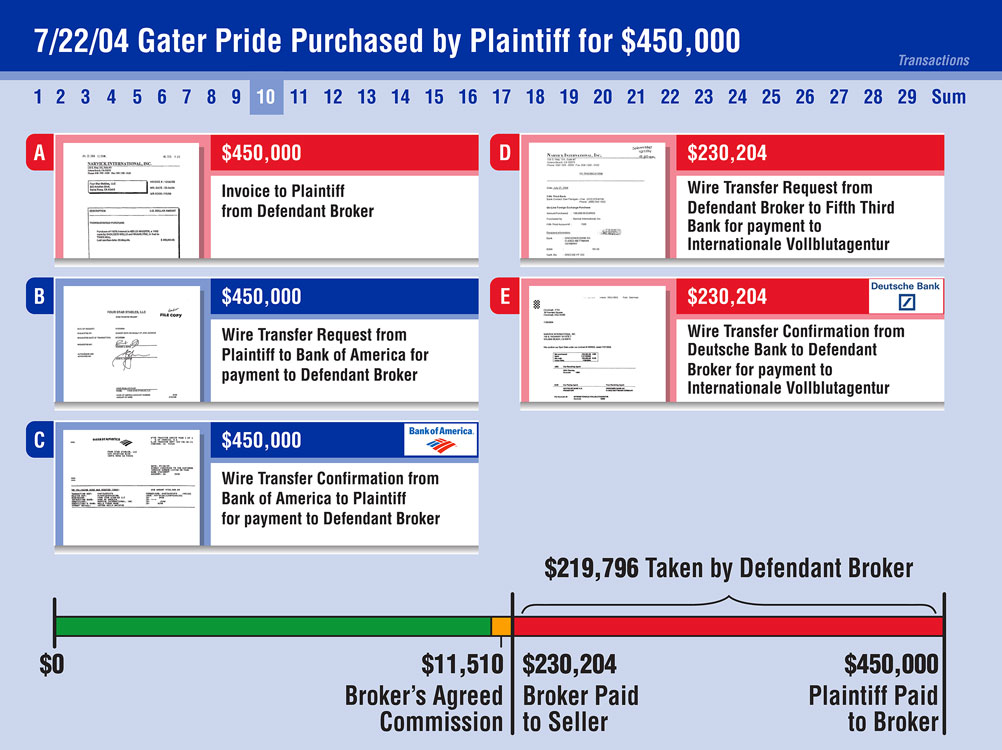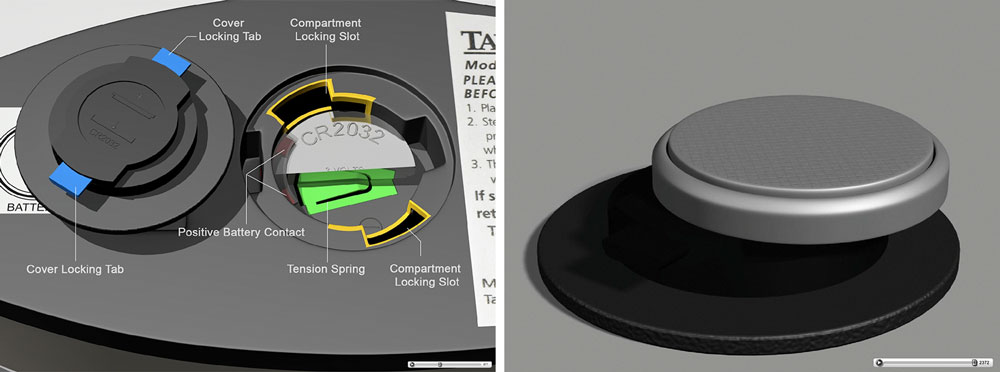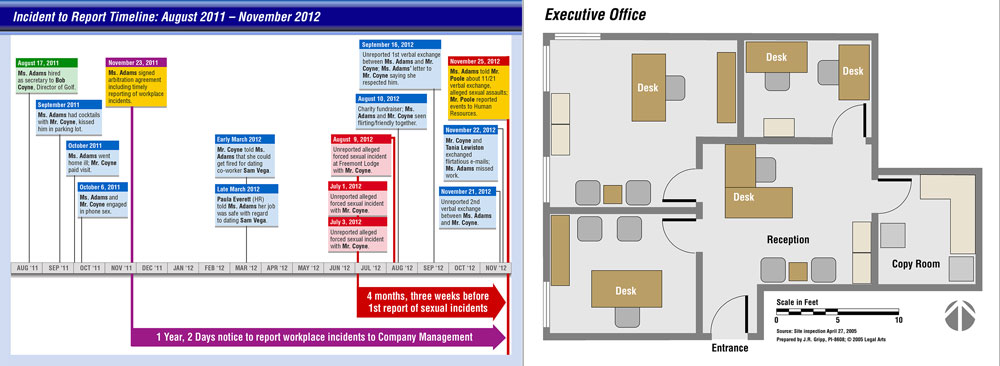
How Mediation Graphics Promote Breakthrough Settlements
Mediation is more popular than ever as a resolution tool because it gauges both your client and opponent’s commitment to settlement, solicits an objective opinion about your strengths and weaknesses, and opens the door to settlement. The coronavirus pandemic has spawned new interest in video mediation to facilitate resolution, and while controversy about its effectiveness exists (1,2) it’s here to stay at least as a cost-savings option.
Litigation graphics are more popular and accessible too. Fact finders and influencers expect visual aids when learning new and unfamiliar topics because visual evidence is convincing and graphical summaries are easier to digest than voluminous documents, esoteric scientific evidence, or dense economic data. And electronic demonstratives are easily integrated into your mediation brief.
Mediation + graphics = no brainer ?
Not necessarily. The literature and my own research confirm graphics are seldom used in mediation as much as mediators prefer because of cost and:
(a) court-ordered mediations occur too early in the discovery process to warrant serious settlement discussions;
(b) unlike binding arbitration or trial, mediations are not decisive so when settlement is unlikely counsel often choose not to reveal their most powerful cards;
(c) mediators can only influence resolution and joint sessions allowing direct influence on the opponent and client have lost popularity; and
(d) the perception graphics are not essential to demonstrating your strengths and the opponent’s weakness.
Arguably, another reason is because litigators don’t understand how to use graphics effectively in mediation.
Graphics can affect outcome directly by convincing the mediator and the other side that a case is too risky to take to trial or warrant additional litigation expense. In my experience, the strongest graphics help to narrow the gap between demand and offer by demonstrating a reasonable benchmark for measuring true value.
Mediators want and need to learn quickly.
Abby B. Silverman, Esq. of JAMS, San Diego expressed a sentiment I’ve heard from other neutrals:
“Mediators need to quickly and efficiently become familiar with complicated fact patterns, relationships, the cast of characters, the background and the backstory. Graphic representation of the facts are good tools to educate the mediator.”(3)
I recently produced a PowerPoint video presentation for mediator screening before a one-day premises liability-personal injury session. At issue was whether the plaintiff, an attorney, suffered a career-ending traumatic brain injury when he walked forehead-first into a closed glass lounge door while reading a document.
Originally, defense counsel requested a a couple dozen videotaped deposition excerpts demonstrating key admissions by the plaintiff and opinions of medical experts and his employer. However, most clips ran long because most witnesses were deliberate, slow talkers. Alternatively, I substituted all but the most persuasive clips with transcript slides timed to display at average reading speed, resulting in a much shorter run time. The mediator appreciated the presentation and counsel believed it had a significant impact on settling the case for much less than the plaintiff’s demand.
Summarize your best evidence.
Graphical summaries enable faster assimilation of the most important evidence, “helping to focus [mediators] on critical issues and saving invaluable time in their analysis of the case”(4) by “avoiding needle-in-the-haystack locating of key documents.”(5)
In a case involving international acquisitions of thoroughbred horse breeding stock, the purchasing agent perpetrated a massive fraud to supplement his 5% commission. In 29 transactions, he forged bills of sale to inflate the purchase prices 35% on average, realized larger commissions, and pocketed $2.9 million, and shared the proceeds with the plaintiff’s trusted trainer who validated the higher priced values.
My team created an interactive graphical presentation for the joint-session mediation that enabled plaintiff’s counsel to cherry pick the most egregious transactions and conveniently follow the paper and money trails. The case settled after mediation and the plaintiff was fully compensated by the defendants.
Demonstrate your strengths and your opponent’s weaknesses.
“When counsel presents critical information with explanatory graphics, it signals the level of professionalism that will confront an opponent if the case does not settle. Making the extra effort to prepare graphics for mediation also can enhance the credibility of counsel’s position.”(6)
Plaintiffs brought a personal injury and product liability case alleging their toddler swallowed a button battery that lodged in her esophagus purportedly originating from a bathroom scale. Because both the scale and battery were discarded and could not be independently examined, the thrust of the defendants’ case in mediation was to cast doubt on the battery’s origin.
We prepared a 3D-animation for mediation demonstrating how the battery compartment cover locking mechanism was designed to work. We demonstrated how both the battery and the cover would have remained together if the latch failed and if the battery was swallowed, the cover would have been found alone. The parents never described recovering the cover, so the logical conclusion was they simply assumed the battery originated from the scale. The case settled after mediation.
Showcase inconsistencies in your opponent’s evidence.
“In employment cases, Defendants often use organization charts and charts with promotion and compensation data to defend against discrimination claims. Chronologies also help with retaliation cases where the timing of an adverse action is important. I also have seen floor plans and diagrams to demonstrate how claimed conduct could not have happened.”(7)
In this employment sexual harassment defense case, we assisted a golf resort’s counsel demonstrate inconsistencies in the plaintiff’s allegations about when and how offenses occurred in the office and off premises. Of particular interest were the substantial time delays between the alleged events and her reporting them to the HR department, and the sightlines of employees in her office where certain events supposedly occurred during the workday. The case eventually was eventually resolved in arbitration.
So popular, yet so rare.
“In our experience, demonstrative evidence is presented far too seldom.”(8)
“A picture is worth 1000 words. We all know that, yet few litigators think to bring visual and demonstrative aides to mediation. They’re missing a good bet. My advice? Use them. At mediation. I mean really use them. … The vast majority of cases settle at mediation. If you keep your best material under wraps to “save it for trial”, it is not likely to see the light of day. Enough said!”(9)
“Graphics rarely are employed by either side in mediation of business and commercial disputes. … In a recent case, counsel resorted to filling a White Board with computations that looked like a calculus class assignment, and I was left to photograph the board hoping to understand how they justified the ‘bottom line.’”(10)
I’ve observed these trends in graphics designed specifically for mediation:
- In every case my clients believed their cases could and should settle during or shortly after mediation; i.e., graphics are seldom commissioned for cases with little or no chance of settlement at mediation
- While joint sessions are rare, they are prime opportunities to present a vigorous argument by summarizing key points and evidence
- Inserting graphics into mediation briefs—especially interactive briefs with hyperlinks to exhibits— is increasingly popular
- Self-running PowerPoint video presentations prepared for the neutral before mediation are well received and acknowledged to be very influential. These commonly feature summary graphics, video clips, transcript excerpts, and documentary evidence.
Where do you stand on this topic? Let me know.
Jim Gripp is a pioneering founder of Legal Arts, Inc. He has over forty years-experience as a litigation graphics consultant and private investigator. Email Jim at jgripp@legalarts.com. Image: Rawpixel.com © shutterstock.com
Endnotes
(1) Jeff Kichanven, “The Era of Video Mediation Is Here – Or Is It?” Law360.com, 6 April 2020, last retrieved 6 April 2020 at https://www.law360.com/trials/articles/1259828/the-era-of-video-m…09d654&utm_source=newsletter&utm_medium=email&utm_campaign=trials
(2) Michael Willemin, “In Defense of Virtual Mediation” Law360.com, 13 April 2020, last retrieved 13 April 2020 at https://www.law360.com/articles/1262765/in-defense-of-virtual-mediation?nl_pk=3c9fedfb-ee54-4069-ad48-58c0f0bd37ec&utm_source=newsletter&utm_medium=email&utm_campaign=special
(3) Mediator Abby B. Silverman, Esq. interview by email on 3 March 2020. Ms. Silverman may be reached at abby@silvermanweiss.com
(4) Michael S. Kun “Use of Demonstrative Evidence in Employment Litigation: A Defense Counsel’s Perspective” Los Angeles County Bar Association Labor and Employment Law Section Annual Retreat, May 5-6, 2007
(5) Monty A. McIntyre, Esq., telephonic interview on 2 March 2020. Mr. McIntyre may be reached at monty@montymcintyre.com
(6) Mediator Charles H. Dick, Esq. interview by email on 2 March 2020. Mr. Dick may be reached at CDick@jamsadr.com
(7) Silverman, supra.
(8) Steven H. Kruis and Monty A. McIntyre, “Using Technology to Effectively Tell Your Story and Get Your Best Settlement During Mediations.” Kruis Mediation, last retrieved 4 April 2020 at http://www.kruismediation.com/articles_4.html
(9) Sheldon Stark, “Using Demonstrative and Visual Aids at Mediation” last retrieved 4 April 2020 at https://www.starkmediator.com/practice-tips/2014/05/01/making-use-demonstrative-visual-aids-mediation/
(10) Dick, supra.



